Cell Migration and Invasion Assay Guidance using Millicell® Cell Culture Inserts
- Migration and Invasion Assay Overview
- What Do I Need to Run a Cell Migration/Invasion Assay?
- Selecting the Right Pore Size for My Cell Migration/Invasion Assay
- Migration and Invasion Assay Optimizations
- Migration and Invasion Assay Sample Protocol
- Migration and Invasion Assay Sample Data
- Migration and Invasion Assay Tips and Tricks
- Product Table
- References
Migration and Invasion Assay Overview
Cell migration is the directed movement of cells in response to a chemical (e.g., chemoattractant) or mechanical stimulus. It is an important property of cells, critical for cell development and normal processes such as wound healing. However, it is also involved in disease states such as inflammation or tumor cell migration and invasion.¹ Migration and invasion assays have long been utilized in cell biology for the study of tumor metastasis, with the most common assays based on the Boyden assay system. This system was first used in 1962 by Dr. Boyden where he demonstrated the use of Millipore® porous membrane for chemotaxis.²
Today, migration assays can be carried out using Millicell® hanging cell culture inserts based on this Boyden assay system, while invasion assays require coating of the membrane with an ECM gel, such as Matrigel®, and then seeding the cells on it. This coating acts as a barrier for cells to penetrate during invasion. Inserts with different pore sizes are available, dependent on the size of the cells to be used.
The Boyden Chamber system uses a hollow plastic chamber and is sealed at one end with a porous membrane. This chamber is then suspended over a larger well which may contain medium and/or chemoattractants. Cells are washed in serum free media to ensure removal of all serum before being added to the apical (top) side of the membrane in the inserts. Media containing the relevant chemoattractant (e.g., Fetal Bovine Serum, various cytokines etc.) is added to the wells below the inserts (along with a negative control where no chemoattractant is in the media), and the cells are left in a 37°C CO₂ incubator for the desired amount of time.
Following this incubation, non-migrated cells are gently removed from the apical side of the membrane and the migrated cells on the basolateral side of the membrane can be quantified using cell staining and imaging.

Figure 1.Invasion assay principle. Cells are seeded in ECM-coated inserts on apical side of the membrane, while media containing the relevant chemoattractant is added to the cell culture plate. Plates are left for the required time (e.g., 24 hours) to allow for invasion of cells to the basolateral side of the membrane. Non-invaded cells are removed with a cotton swab, and invaded cells are fixed and stained before imaging and counting. For migration assays, simply omit the ECM-coating step.
What do I need to run a migration/invasion assay?
- Millicell® Cell Culture Inserts (see insert selection below)
- Extracellular Matrix (e.g. Corning® Matrigel® Basement Membrane Matrix)
- Tissue culture plates
- Cell lines
- Cell culture media
- Chemoattractant (e.g., Fetal Bovine Serum)
- Fixing Solution (e.g., 70% ethanol or 4% paraformaldehyde)
- Sterile forceps
- Cotton swabs
- Staining solution (e.g., Crystal Violet or DAPI)
- Sterile water
Selecting the Right Pore Size for My Cell Migration/Invasion Assay
The pore size of your insert depends on the type of cells that are to be used in your assay. It’s important that too large of a pore size isn’t used for smaller cell types, but the pores can’t be so small that migratory cells cannot fit through even in the presence of the chemoattractant. Table 1 shows membrane pore size recommendations for a selection of migratory and invasive cell types based on literature.
Millicell® hanging cell culture inserts have several options compatible with migration and invasion assays (shown in Table 2). All inserts are individually blister-packed and fit standard tissue culture plates.
Migration and Invasion Assay Optimizations
- Insert selection: See “Selecting a Millicell® Cell Culture Insert for migration and invasion assays” in the section above.
- Cell seeding density: It’s important to optimize the seeding density for your particular cell line. At a concentration that is too high, the cells will be hard to count or could oversaturate the pores in the membrane. Too few cells added could lead to inconsistent counting and results.
- Chemoattractant concentration: Optimization of your chemoattractant of interest is an important step, especially if there are no previously published data on the interaction between the cell line you’re using and the chemoattractant. In this case, it can be good to run the assay with several different serial dilutions of the chemoattractant. Response of different cell types can be varied depending on the chemoattractant used. For a well-studied chemoattractant, such as FBS, a concentration of 10% serum is a good place to start while you are optimizing your seeding density.
- Timing: It’s important to optimize the incubation time for your migration assays as the most appropriate incubation time depends on the cell type and the chemoattractant that is used (typically, 16-24 hours is a good starting point, but some cell lines may take longer).
- Cell staining and counting: There are several different methods of staining that can be used when you want to image and count your migrated cells. These include crystal violet (whole cell staining) and DAPI stain (staining of the cell nuclei). Once fixed and stained, the cells can be visualized and quantified using an inverted microscope.
- Media volumes: Millicell® hanging cell culture inserts are compatible with most tissue culture plates. As well dimensions can vary slightly across brands, it’s best practice to optimize how much media is needed in the well so that it reaches the same level as the media in the insert itself. For 24-well formats, good starting points are 100 µL in the insert with 600 µL in the well, or 200 µL in the insert and 900 µL in the well.
Migration and Invasion Assay Sample Protocol – Optimization of Seeding Density
Materials:
- High migratory / invasive cell line, e.g., HT 1080 cells
- High migratory cell line, e.g., NIH 3T3 cells
- Low migratory cell line, e.g., MCF-7 cells
- Millicell® Cell Culture Inserts, 8 μM PET, 24-well
- Corning® Costar® 24-well plates
- Greiner 75 cm² tissue culture flasks
- Trypsin-EDTA solution
- EDTA 0.02% solution in D-PBS
- Corning® Matrigel® Growth Factor Reduced (GFR) Basement Membrane Matrix
- Coating buffer
- 0.01M Tris (pH 8.0)
- 0.7% NaCl
- HT 1080 & MCF-7 apical medium / control medium (no serum)
o EMEM
o 50 units Penicillin / 50 µg/mL Streptomycin
o 2 mM L-glutamine
o Non-Essential Amino Acids
- HT 1080 & MCF-7 culture medium / basolateral test medium (10% FBS)
o EMEM
o 50 units Penicillin / 50 µg/mL Streptomycin
o 2 mM L-glutamine
o Non-Essential Amino Acids
o 10% FBS
- NIH 3T3 culture medium (10% Calf Serum)
o DMEM
o 50 units Penicillin / 50 µg/mL Streptomycin
o 2 mM L-glutamine
o 10% Calf Serum
- NIH 3T3 apical medium/control medium (no serum)
o DMEM
o 50 units Penicillin / 50 µg/mL Streptomycin
o 2 mM L-glutamine
- NIH 3T3 basolateral test medium (10% FBS)
o DMEM
o 50 units Penicillin / 50 µg/mL Streptomycin
o 2 mM L-glutamine
o 10% FBS
Coating Protocol for Invasion Assays
- Aliquot and store Matrigel® at -20°C. Thaw aliquot on ice or at 4°C.
- Prepare coating solution by diluting Matrigel with chilled coating buffer to a final concentration of 200 µg/mL. Gently swirl to mix and store on ice until further use.
- Tip: Chill pipette tips and/or other materials that come into contact with Matrigel® during this step.
- Using sterile forceps, place the desired number of Millicell® hanging inserts into 24-well tissue culture plates.
- Carefully pipette 100uL of coating solution to the center of the apical side of the inserts and, without shaking, incubate the closed plate at 37°C for 2-3 hours. Once done, make sure to follow the next steps quickly to avoid the gel drying out.
Day 1: Seeding Cell Culture Inserts with Cells
- Cells were detached from cell culture flasks and resuspended in culture medium containing serum to neutralise trypsin.
- The cells were washed twice in serum-free medium to ensure removal of all serum.
- The cell suspension was counted and serially diluted to required concentrations in serum-free medium.
- Using a sterile forceps, the cell culture inserts were removed from their packaging and placed into culture plate wells. This was repeated until the desired number of wells contained inserts. For invasion assays, use ECM-coated cell culture inserts, as described above.
- The cells were seeded onto the inside of the insert, on the apical side of the membrane (100 µL of each cell suspension).
- 600 µL assay media was added to the basolateral side of each insert in the wells. This media contained 10% FBS as a chemoattractant for test samples in half of the plate, while serum-free media was used as a control in the other half of the plate. Three replicates were used per seeding density for those with and without FBS in the media. An insert without cells was included as a blank control. The seeded plates were placed in a humified incubator at 37°C, 5% CO₂ for 24 hours.
Day 2: Evaluation of Migrated Cells
- The media was removed from the wells of the 24-well plate.
- Using a cotton swab moistened in media, the remaining cells that did not migrate from the apical side of the membrane in the insert were gently removed. This was done by carefully swirling the moistened cotton swab several times around the insert in a clockwise and anti-clockwise direction. It’s very important that you are careful not to damage the membrane here.
- The cells were fixed in 4% paraformaldehyde for 10 min before washing twice with PBS.
- The cells were permeabilized in 0.1% Triton X-100 for 10 min before washing twice with PBS.
- Cells were then stained with 1 µM DAPI solution for 15 min and washed once in PBS.
- 900 µL of molecular grade water was added to the well of the 24-well plate, and 200 µL to the apical side of the insert within the 24-well plate.
- The inserts were imaged directly from 24-well plate on the DAPI filter using a 10x objective. It’s important to keep image settings consistent between the samples.
- Images were acquired and migrated cells were counted in four fields of view for each insert.
- Staining with 0.5% crystal violet was also completed. 900 µL of PBS was added to the well of the 24-well plate, and 200 µL of molecular grade water to the apical side of the insert within the 24-well plate, before imaging.
Samples can be saved and re-stained if needed. The inserts can be stored at 4 °C in molecular-grade water.
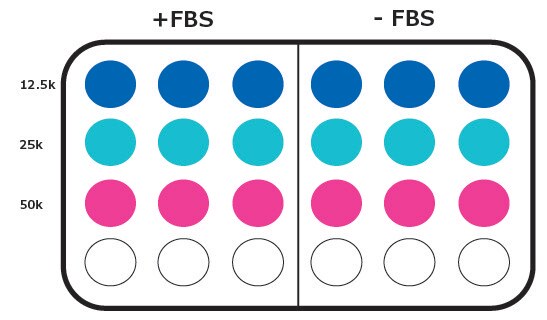
Figure 2.Example of 24-well plate layout for optimizing seeding density for cell migration assays (or invasion assays if using Matrigel®-coated inserts).
Sample migration and Invasion assay data
Migration and invasion assays were performed as described in the previous section. Crystal violet staining was carried out following these 24-hour migration assays, for three cell lines (HT 1080, NIH 3T3, and MCF-7) with and without 10% FBS. This allowed for migrated cells to be imaged clearly, showing the level of migration for each cell line under each condition (images shown in Figure 3). HT 1080 cells are capable of invasion and migration, NIH 3T3 cells are capable of migration only under the conditions outlined in this experiment, while MCF-7 cells are incapable of migrating through the pores towards the chemoattractant.
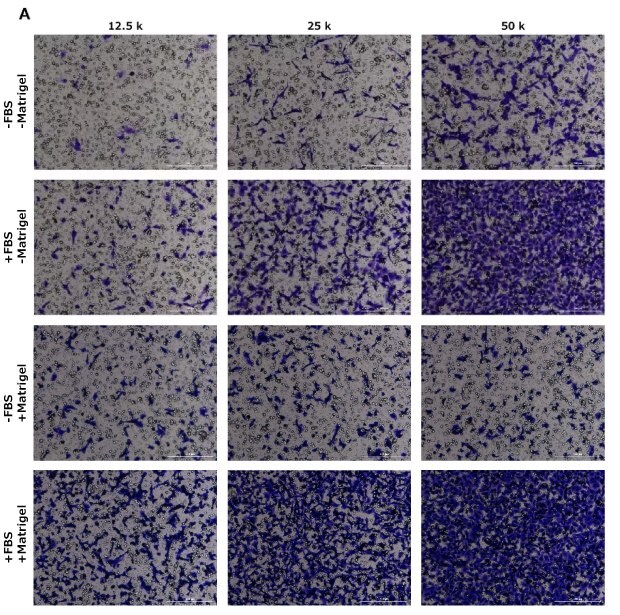
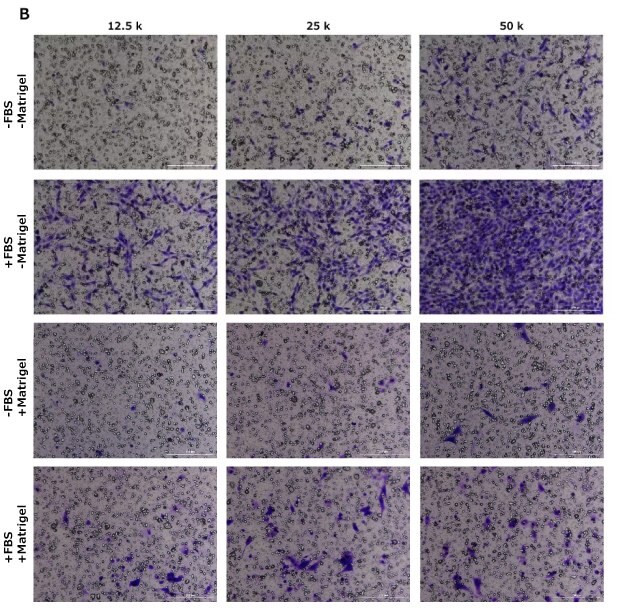
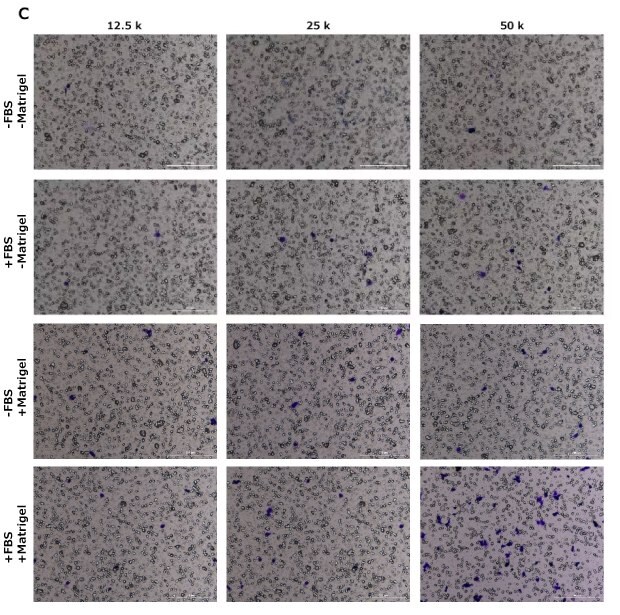
Figure 3.Crystal violet staining of migrated cells (A – HT1080, B – NIH 3T3, C – MCF-7) on basolateral side of membrane after 24 hours, with and without 10% FBS and Matrigel® (200 µg/mL), at different seeding densities. Representative images are shown from one field of view, from one insert replicate at each seeding density. HT 1080 and NIH 3T3 cell lines can migrate through the pores towards the chemoattractant, while MCF-7 cells cannot. Only the HT 1080 cell line can invade through the Matrigel®-coated membrane.
In addition to crystal violet staining, cells were also stained with DAPI to allow for imaging and counting using a fluorescent microscope (shown in Figure 4). Imaging was completed using a 10x objective with the DAPI filter. Once the images were acquired, migrated/invaded cells could be counted in four fields of view for every insert. DAPI is a nuclear stain, which allows for easier counting of migratory/invaded cells, especially when there are large numbers of cells present in the higher seeding densities.
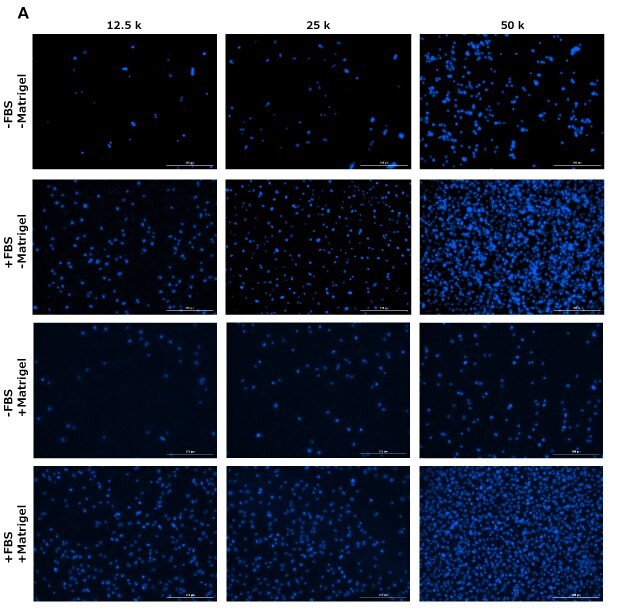
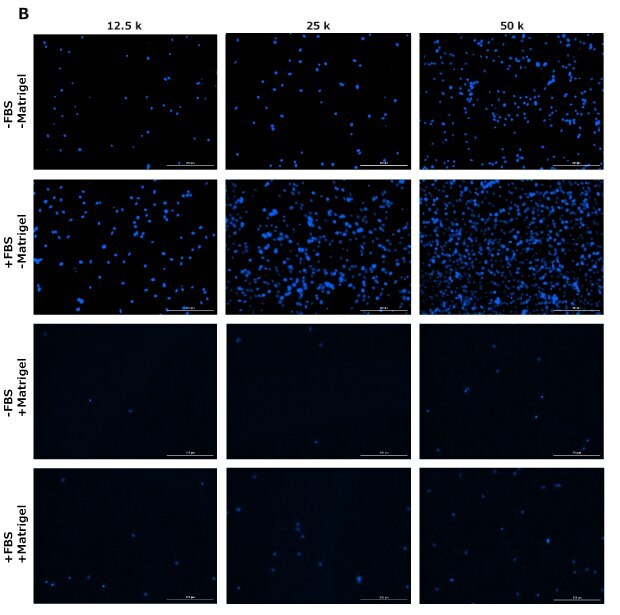
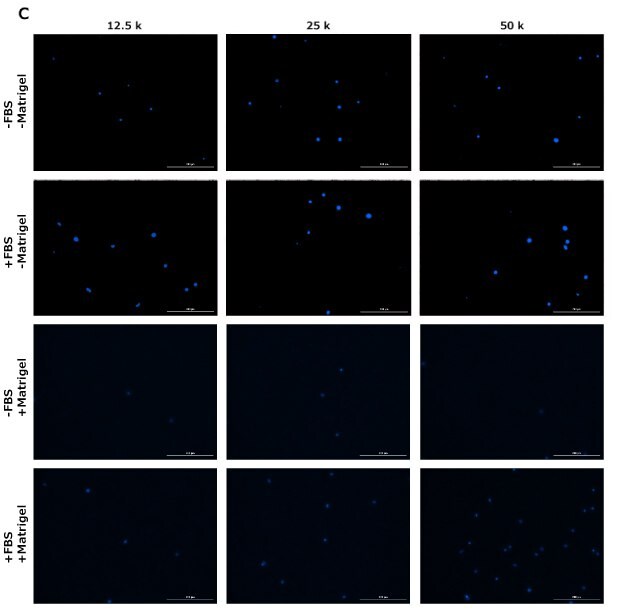
Figure 4.DAPI staining of migrated cells (A – HT1080, B – NIH 3T3, C – MCF-7) on basolateral side of membrane after 24 hours, with and without 10% FBS and Matrigel® (200 µg/mL), at different seeding densities. Representative images are shown from one field of view, from one insert replicate at each seeding density. HT 1080 and NIH 3T3 cell lines can migrate through the pores towards the chemoattractant, while MCF-7 cells cannot. Only the HT 1080 cell line can invade through the Matrigel®-coated membrane.
The objective of this experiment was to optimize seeding density for a migration and invasion assays using 10% FBS as a chemoattractant for three different cell lines, following 24 hours of incubation. The number of cells that migrated or invaded in each insert was calculated by averaging the number of cells across four fields of view following DAPI staining and imaging. Graphical representations of the results are shown in Figure 5. These results allowed us to determine that the optimal seeding density in this experiment was 25,000 cells per insert for both migration and invasion assays. There was a good separation of cell counts between inserts that contained the chemoattractant (+FBS) and the negative control (-FBS), with 25,000 cells per insert seeding density showing the best signal-to-noise ratio for the two migratory cell lines (5:1 and 6:1 for HT 1080 and NIH 3T3 respectively). Corresponding controls were tested for each cell line to compare both with and without FBS conditions (data not shown). Appropriate seeding density is dependent on the specific conditions to be tested by the user (e.g., time of migration, the cell line used, chemoattractant used, etc.)
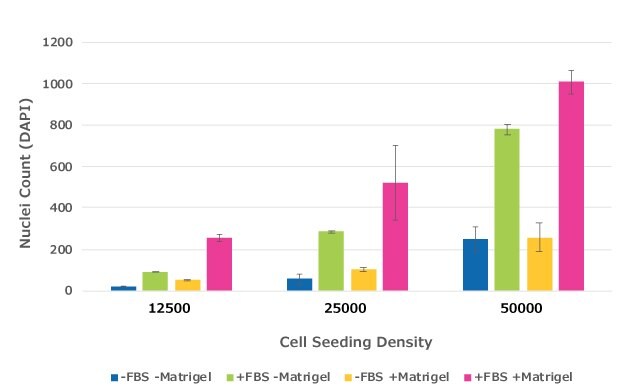
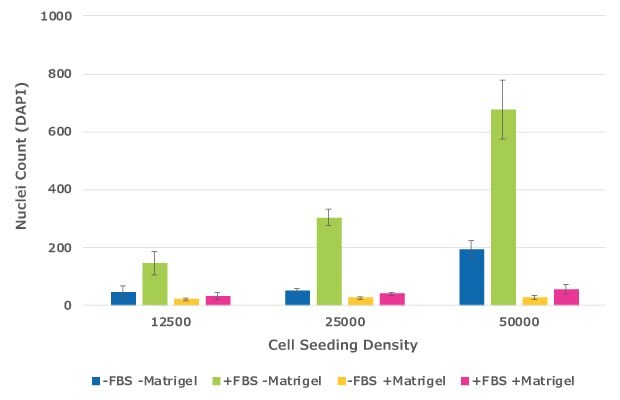
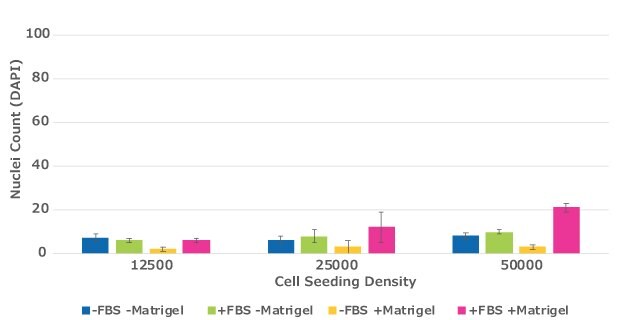
Figure 5.Quantification of migrated cells on the basolateral side of membranes after 24 hours, with and without 10% FBS and Matrigel® (200 µg/mL), at different seeding densities (showing the average of cells counted from four fields of view, from three insert replicates). HT 1080 and NIH 3T3 cell lines can migrate through the pores towards the chemoattractant, while MCF-7 cells cannot. Only the HT 1080 cell line can invade through the Matrigel®-coated membrane.
Migration and Invasion assay tips and tricks
- It is important to include cell culture inserts in media without chemoattractant as a negative control, as well as to identify background migration. Additionally, non-migratory cell lines (e.g., MCF-7) can be used as an added control.
- When preparing cell suspensions, be careful to break up clumps of cells (gently pipette manually with a smaller bore pipettor) to avoid aggregation of cells in the middle or edges of the insert. Always use warmed media to ensure cells don’t aggregate.
- Ensure that cell culture inserts are placed properly in the well of the tissue culture plate. There are several different types of plates that can be used with hanging inserts, so it’s important that the inserts are seated correctly to allow for even migration/invasion. Make sure the lid of the plate can close properly to prevent evaporation during incubation (you can use a clean gloved hand to move cell culture inserts into place after transfer using forceps if they shift out of place).
- Be sure to suspend cells in serum-free media and gently pipette them few times before seeding them onto wells to avoid any contamination and reduce clumping of cells.
- It is crucial to optimize different parameters such as duration of invasion, seeding densities and Matrigel® concentration depending on the experiment and cell type chosen for better accuracy and results.
- Aliquot Matrigel® bottle initially to avoid multiple freeze/thaw cycles. Thaw individual vials when needed.
- As much as possible, avoid air bubbles while pipetting Matrigel® into each insert.
- Be sure the Matrigel® coating is evenly distributed and solidified prior to seeding cells. Use forceps to lift the insert and visually inspect.
- Be very careful when removing the non-migratory/invasive cells from the apical side of the membrane. Too much pressure can lead to the membrane becoming detached or could displace some of the cells that have migrated/invaded (Figure 6).
- Pick up the cell culture inserts using forceps and then transfer the insert to a clean gloved hand to aid with grip when swabbing the insert. Ensure that you don’t touch the actual membrane itself in the process.
- Different fixative agents can be used such as 70% ethanol or 7% paraformaldehyde. When using alcohol to fix cells, combined with crystal violet staining, ensure that you image and count the cells within a window of a few days as the cell structures can appear blurred and can be harder to count if left for too long.
- After staining, Millicell® inserts should be properly stored to avoid drying out and blurry images.
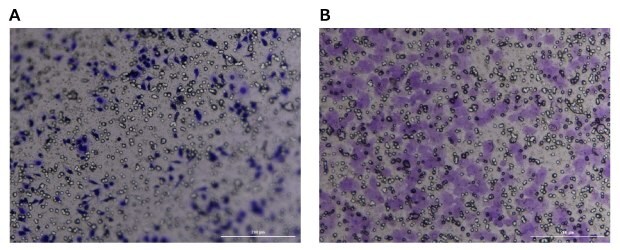
Figure 6.Crystal violet staining of Millicell® inserts. A. Too much pressure was placed on the Millicell® insert when removing it, indenting the membrane and causing the insert not to be in the same focal plane when imaging. B. Crystal violet staining of Millicell® inserts using ethanol as a fixative agent. When using ethanol as a fixative agent, samples should be images as soon as possible to avoid ethanol distortion of cell morphology.
Products
1 - 20
21 - 40
41 - 49
To continue reading please sign in or create an account.
Don't Have An Account?